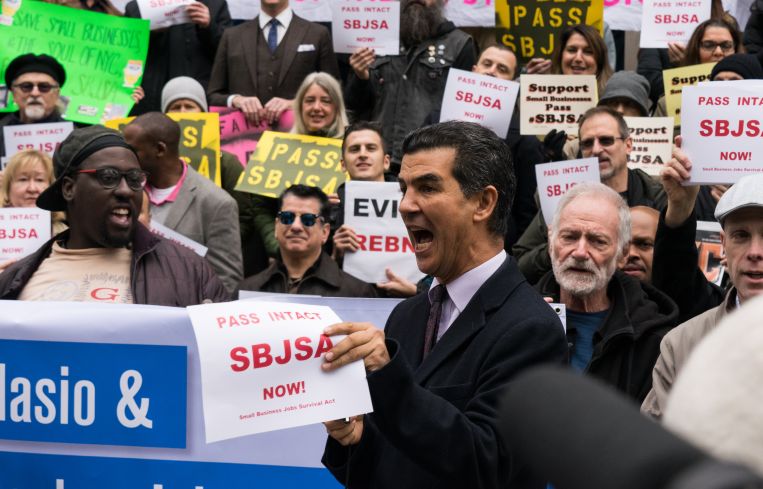What Is the Real Vacancy Rate for Manhattan Storefronts? Not 20 Percent! [Updated]
By Rebecca Baird-Remba November 5, 2018 10:44 pm
reprints
During a hearing last month on what has controversially become known as the “commercial rent control bill,” supporters of the legislation argued that the proposal—called the Small Business Jobs Survival Act (SBJSA)—was necessary because “20 percent of Manhattan storefronts are vacant.” There’s just one problem: no one actually knows how many storefronts are empty, either in Manhattan or elsewhere in the five boroughs.
The statistic appeared in a Sept. 6 New York Times article on vacant storefronts and was attributed to Faith Hope Consolo, a veteran retail broker and the head of Douglas Elliman’s retail leasing division. Now she’s saying it’s wrong.
“A survey conducted by Douglas Elliman found that about 20 percent of all retail space in Manhattan is currently vacant, she said, compared with roughly 7 percent in 2016,” the Times noted in the fourth paragraph of the story. Consolo, for her part, argues that she was misquoted, and that what the reporter should have said was that the figure represents availability—not vacancy. She told Commercial Observer that the report in question doesn’t exist, but Elliman did conduct an “internal survey” on retail data.
![What Is the Real Vacancy Rate for Manhattan Storefronts? Not 20 Percent! [Updated] Faith Hope Consolo](https://observer-media.go-vip.net/wp-content/uploads/sites/3/2014/12/faith-2.png?w=300)
“There was no report, no report ever existed,” she explained to CO. “It was not really a report—every group does their own internal survey. We always rate how much space is becoming available.”
The broker even penned a letter to the Times editor on Sept. 21, where she explained that the 20 percent figure was supposed to represent an increase in available retail space over the past 15 years.
“Retail square footage has grown 20 percent since 2004 due to new developments bringing new space to the market,” she claims in her letter. Her estimate includes large blocks of new retail construction that are still leasing up, including Hudson Yards, the World Trade Center and the South Street Seaport, she told CO.
“Some companies were acquired, there was a lot of consolidation, but the fundamentals are that there’s not 20 percent empty stores,” she said to CO. Since the Times piece ran two months ago, the 20-percent figure has been cited in many outlets, including The Atlantic, CityLab, The Real Deal and Vox.
Corey Kilgannon, the Times metro reporter who wrote the piece on vacant storefronts, said in an email to CO, “I’m sorry to hear she is now taking issue with it, but I’m confident I quoted her correctly.”
The SBJSA—which was first proposed in 1986—would require all commercial landlords to offer their commercial tenants a 10-year lease renewal. Landlords would make an offer to a tenant, who could choose to reject it and go through a binding arbitration process to set a new rent. The current bill would apply to all commercial tenants, from J.P. Morgan Chase to the 200-square-foot nail salons and wine shops in the outer boroughs. Proponents of the legislation have wielded the 20-percent-vacancy stat, and the concept of empty storefronts, as a justification for why the city’s commercial tenants deserve better protection from rising rents and greedy landlords. And real estate pros posit that no one—neither the big commercial brokerages nor Douglas Elliman, which is known mostly for its residential business—has comprehensive retail vacancy data. So, they ask, how can officials be sure the city needs this policy that would completely upend the commercial office and retail market?
At the Oct. 22 hearing, Manhattan Borough President Gale Brewer and other proponents of the SBJSA sought to answer that question by pushing for a citywide vacant-store registry, which would help provide definitive data on where empty storefronts are located and allow officials to nail down the actual citywide vacancy rate.
“I don’t know at what number [vacancy] is a problem or not a problem,” Cushman & Wakefield broker Steven Soutendijk, who testified against the SBJSA at the hearing two weeks ago, told CO. “What if this vacant store registry says the citywide vacancy rate is under 10 percent? If the citywide vacancy rate is sub-10 percent, and I suspect it is, does that require legislation?”
City officials are not completely at a loss for retail data. The New York City Department of Small Business Services, which collects information on storefront vacancies from the city’s 76 business improvement districts, found that the average storefront vacancy rate throughout the five boroughs was 5.6 percent for fiscal year 2017. But the data is self-reported, unlike research collected by the brokerages.
Consolo argued that 20 percent of Manhattan’s retail space is available for lease. On this point, she is somewhat correct. In its third-quarter report, C&W found that Manhattan’s overall retail availability rate was roughly 20 percent. But the big commercial brokerage only tracks the most expensive Manhattan retail corridors, like Soho, Times Square, and an 18-block-stretch of upper Fifth Avenue, which represent 2 or 3 percent of the retail space for the entire borough.
“What we track represents 1 or 2 percent of the total retail percentage in the five boroughs,” Soutendijk said to CO. “Imagine how much work it would take to track vacancy in all five boroughs. It would take no less than a hundred people and three to four months minimum for that undertaking to be successful.”
He was quick to emphasize the difference between vacancy and availability. From a data perspective, a storefront might be on the market, but that doesn’t necessarily mean it’s empty, because it could have a long-term or pop-up tenant filling it.
“We are not as concerned with vacancy as availability,” he explained. “I think the spread between availability and vacancy especially in markets like Soho is meaningful. I think the availability [rate] is twice as big as the actual vacancy rate.”
Nicole LaRusso, the director of research for the tri-state region at CBRE, told CO that 20 percent vacancy “seems a little high no matter what you’re looking at.” She pegged the availability rate for the Manhattan retail corridors that CBRE tracks at closer to 15 percent, because the brokerage does not track vacancy. And she pointed out that vacant storefronts are sometimes just under construction or awaiting a new tenant.
“As a layperson when you’re walking down the street, if you’re seeing a store that’s dark, it can give you a sense that this market is suffering,” LaRusso explained. “But maybe they’re closed because the lease ran out and that tenant isn’t going to renew and the landlord is marketing it to someone else. There’s a constant churn, so you might not always know what’s really going in if you’re not doing what we’re doing—calling the landlord and the tenant rep” to see what’s going on.
Nevertheless, supporters of the SBJSA aren’t concerned the 20 percent vacancy figure may be incorrect.
“It doesn’t matter if the 20 percent statistic is spot-on accurate or not, the reality is any New Yorker can walk around his/her neighborhood and see vacant storefronts all over commercial corridors that were thriving,” said Kirsten Theodos of Take Back NYC, one of the main groups supporting the bill, in an email to CO. “The small business crisis has reached every borough—as we heard from other councilmembers at the hearing—and is no longer just a Manhattan problem. It is the hope of small-business owners and advocates that the focus remains on finding a solution that addresses high rents and is not derailed by proposed measures to be taken after the business loses its lease, like vacancy taxes.”
Update: This story has been updated to reflect the fact that CBRE tracks availability, not vacancy, and that the 15 percent figure referred to availability rather than vacancy.


